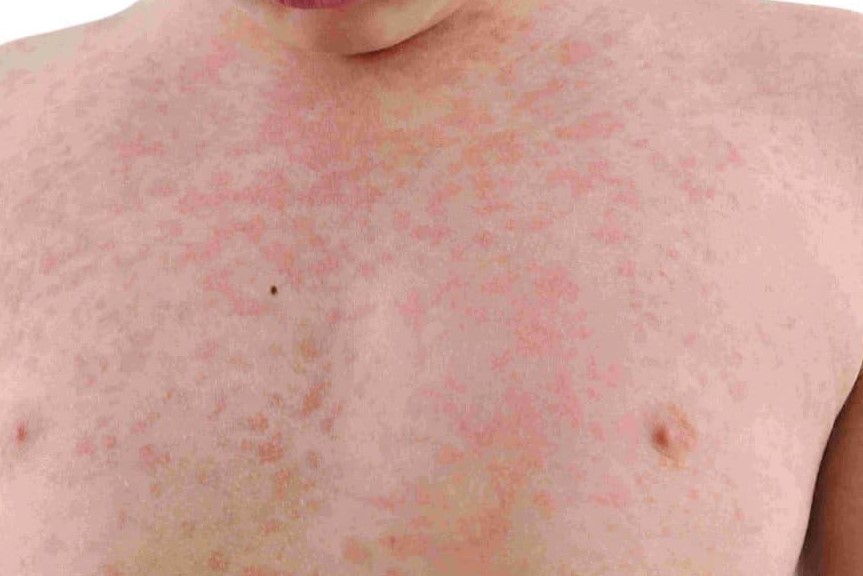
Scarlet fever: contagion, symptoms and treatment
Scarlet fever and its younger sister, the fourth disease, are the only two exanthematous diseases to be caused not by a virus but by a bacterium, namely group A β-haemolytic streptococcus (SBEGA)
They are characterised by a bright red punctiform exanthem and a characteristic enanthem of the oral mucosa.
How scarlet fever is transmitted
It is typical of temperate climate zones, not being known in tropical countries and sub-arctic regions.
It strikes preferably in autumn and winter and over the years has a decreasing incidence, probably due to the use of antibiotics to which streptococcus is sensitive.
CHILD HEALTH: LEARN MORE ABOUT MEDICHILD BY VISITING THE BOOTH AT EMERGENCY EXPO
It is transmitted by direct contact from a sick person or healthy carrier, or through infected materials such as dishes, toys or laundry.
The groups most affected are those between 5 and 8 years old (primary school) and between 18 and 20 years old, in relation to military service in countries where conscription is compulsory.
Signs and symptoms of scarlet fever
The incubation time is shorter than for other exanthematic diseases, ranging from 24 hours to 5 days.
The onset is abrupt, with even high fever, headache, nausea, dysphagia.
The tongue is covered with a whitish patina in the centre, while it appears reddened at the edges and tip (strawberry tongue, in which the reddened papillae emerge on the whitish patina), the pharynx is oedematous and strongly reddened, with swollen tonsils often covered with a yellowish exudate, easily removed with a spatula.
This period of 24-48 hours is followed by that of the eruption, in which the initial symptomatology worsens: the whitish patina on the tongue disappears, giving way to a diffuse reddening with hypertrophic papillae (raspberry tongue); the pharynx worsens as reddening and swelling, while the rash appears, starting at the root of the limbs and the anterior thorax, spreading rapidly to the back, neck, abdomen and limbs, leaving the palms of the hands and soles of the feet unscathed.
It consists of maculo-papules 1 mm in diameter, surrounded by a reddened halo that gives the sick person’s skin a diffuse red appearance (hence the term scarlet fever).
The facial features are characteristic, with the perioral and chin area unharmed while the rest of the skin is uniformly reddened (Filatov’s mask).
Other signs that are not always present are white dermographism (when a pencil is swiped over the skin, a whitish stripe forms that lasts a few seconds) and De Toni’s yellow hand sign (when an open hand is pressed on the flushed abdomen and lifted, the light-coloured mark remains for a short time).
The eruption lasts 5-7 days and regresses in the same order as it appeared, with one characteristic phenomenon: that of desquamation, which may be microscopic on the face but with large scales on the hands and feet.
What are the complications
Once very frequent, they consist of septic complications (tonsillar abscesses, purulent otitis, purulent rhinosinusitis, carditis), early toxic complications (affecting the heart, joints, kidney and liver) and immunological complications (arthritis, myocarditis and nephritis).
With the advent of antibiotics, the frequency of complications has fortunately greatly decreased.
Scarlet fever therapy
Scarlet fever is the only infectious exanthematous disease that requires antibiotic treatment, being caused by SBEGA: penicillin G or penicillin V are the two drugs of choice.
Other antibiotics such as macrolides and β-lactams are also active on streptococcus, but to a lesser extent than penicillin.
Only in hypertoxic forms can cortisone be used.
How to prevent scarlet fever
The only form of prevention is to isolate the infected child for at least 2 days after the start of antibiotic therapy.
A vaccine, which is not yet available, is being studied.
Unlike other exanthematic diseases, scarlet fever does not give permanent immunity, so it can also be repeated several times in the course of a lifetime.
Read Also:
Emergency Live Even More…Live: Download The New Free App Of Your Newspaper For IOS And Android
Sore Throat: How To Diagnose Strep Throat?
Sore Throat: When Is It Caused By Streptococcus?
Scarlet Fever, The Pediatrician: “There Is No Specific Vaccine And Does Not Give Immunity”
Pharyngotonsillitis: Symptoms And Diagnosis


